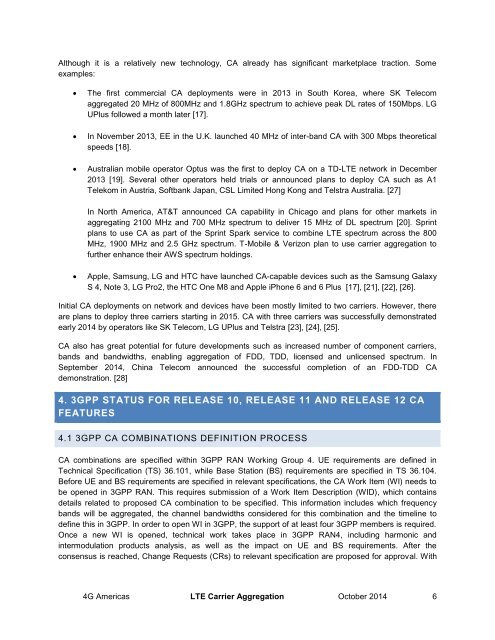4G Americas Carrier Aggregation_FINALv1 0 (2)
4G Americas Carrier Aggregation_FINALv1 0 (2)
4G Americas Carrier Aggregation_FINALv1 0 (2)
You also want an ePaper? Increase the reach of your titles
YUMPU automatically turns print PDFs into web optimized ePapers that Google loves.
Although it is a relatively new technology, CA already has significant marketplace traction. Someexamples:The first commercial CA deployments were in 2013 in South Korea, where SK Telecomaggregated 20 MHz of 800MHz and 1.8GHz spectrum to achieve peak DL rates of 150Mbps. LGUPlus followed a month later [17].In November 2013, EE in the U.K. launched 40 MHz of inter-band CA with 300 Mbps theoreticalspeeds [18].Australian mobile operator Optus was the first to deploy CA on a TD-LTE network in December2013 [19]. Several other operators held trials or announced plans to deploy CA such as A1Telekom in Austria, Softbank Japan, CSL Limited Hong Kong and Telstra Australia. [27]In North America, AT&T announced CA capability in Chicago and plans for other markets inaggregating 2100 MHz and 700 MHz spectrum to deliver 15 MHz of DL spectrum [20]. Sprintplans to use CA as part of the Sprint Spark service to combine LTE spectrum across the 800MHz, 1900 MHz and 2.5 GHz spectrum. T-Mobile & Verizon plan to use carrier aggregation tofurther enhance their AWS spectrum holdings.Apple, Samsung, LG and HTC have launched CA-capable devices such as the Samsung GalaxyS 4, Note 3, LG Pro2, the HTC One M8 and Apple iPhone 6 and 6 Plus [17], [21], [22], [26].Initial CA deployments on network and devices have been mostly limited to two carriers. However, thereare plans to deploy three carriers starting in 2015. CA with three carriers was successfully demonstratedearly 2014 by operators like SK Telecom, LG UPlus and Telstra [23], [24], [25].CA also has great potential for future developments such as increased number of component carriers,bands and bandwidths, enabling aggregation of FDD, TDD, licensed and unlicensed spectrum. InSeptember 2014, China Telecom announced the successful completion of an FDD-TDD CAdemonstration. [28]4. 3GPP STATUS FOR RELEASE 10, RELEASE 11 AND RELEASE 12 CAFEATURES4.1 3GPP CA COMBINATIONS DEFINITION PROCESSCA combinations are specified within 3GPP RAN Working Group 4. UE requirements are defined inTechnical Specification (TS) 36.101, while Base Station (BS) requirements are specified in TS 36.104.Before UE and BS requirements are specified in relevant specifications, the CA Work Item (WI) needs tobe opened in 3GPP RAN. This requires submission of a Work Item Description (WID), which containsdetails related to proposed CA combination to be specified. This information includes which frequencybands will be aggregated, the channel bandwidths considered for this combination and the timeline todefine this in 3GPP. In order to open WI in 3GPP, the support of at least four 3GPP members is required.Once a new WI is opened, technical work takes place in 3GPP RAN4, including harmonic andintermodulation products analysis, as well as the impact on UE and BS requirements. After theconsensus is reached, Change Requests (CRs) to relevant specification are proposed for approval. With<strong>4G</strong> <strong>Americas</strong> LTE <strong>Carrier</strong> <strong>Aggregation</strong> October 2014 6


